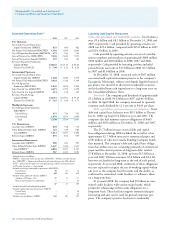Chevron 2008 Annual Report Download - page 38
Download and view the complete annual report
Please find page 38 of the 2008 Chevron annual report below. You can navigate through the pages in the report by either clicking on the pages listed below, or by using the keyword search tool below to find specific information within the annual report.
Management’s Discussion and Analysis of
Financial Condition and Results of Operations
36 Chevron Corporation 2008 Annual Report
the Henry Hub price was about $5.60 and $4.70 per MCF,
respectively. Fluctuations in the price for natural gas in the
United States are closely associated with the volumes pro-
duced in North America and the inventory in underground
storage relative to customer demand. U.S. natural gas prices
are also typically higher during the winter period when
demand for heating is greatest.
Certain other regions of the world in which the com-
pany operates have different supply, demand and regulatory
circumstances, typically resulting in lower average sales prices
for the company’s production of natural gas. (Refer to page
42 for the company’s average natural gas realizations for
the U.S. and international regions.) Additionally, excess-sup-
ply conditions that exist in certain parts of the world cannot
easily serve to mitigate the relatively higher-price conditions
in the United States and other markets because of the lack of
infrastructure to transport and receive liquefied natural gas.
To help address this regional imbalance between supply
and demand for natural gas, Chevron continues to invest in
long-term projects in areas of excess supply to install infra-
structure to produce and liquefy natural gas for transport by
tanker, along with investments and commitments to regasify
the product in markets where demand is strong and supplies
are not as plentiful. Due to the significance of the overall
investment in these long-term projects, the natural gas sales
prices in the areas of excess supply (before the natural gas is
transferred to a processing facility) are expected to remain
below sales prices for natural gas that is produced much
nearer to areas of high demand and can be transported in
existing natural gas pipeline networks (as in the United
States or Thailand).
Besides the impact of the fluctuation in price for crude
oil and natural gas, the longer-term trend in earnings for the
upstream segment is also a function of other factors, includ-
ing the company’s ability to find or acquire and efficiently
produce crude oil and natural gas, changes in fiscal terms
of contracts, changes in tax rates on income, and the cost of
goods and services.
Chevron’s worldwide net oil-equivalent production in
2008, including volumes produced from oil sands, averaged
2.53 million barrels per day, a decline of about 90,000 barrels
per day from 2007 due mainly to the impact of higher prices
on volumes recovered under certain production-sharing and
variable-royalty agreements outside the United States and
damage to production facilities in September 2008 caused by
hurricanes Gustav and Ike in the U.S. Gulf of Mexico. (Refer
to the discussion of U.S. upstream production trends in the
“Results of Operations” section on page 38. Refer also to
the “Selected Operating Data” table on page 42 for a list-
ing of production volumes for each of the three years ending
December 31, 2008.)
The company estimates that oil-equivalent production
in 2009 will average approximately 2.63 million barrels per
day. This estimate is subject to many uncertainties, includ-
ing quotas that may be imposed by OPEC, price effects
on production volumes calculated under cost-recovery and
variable-royalty provisions of certain contracts, changes in
fiscal terms or restrictions on the scope of company opera-
tions, delays in project startups, fluctuations in demand for
natural gas in various markets, weather conditions that may
shut in production, civil unrest, changing geopolitics, or
other disruptions to operations. Future production levels also
are affected by the size and number of economic investment
opportunities and, for new large-scale projects, the time lag
between initial exploration and the beginning of production.
Most of Chevron’s upstream investment is currently being
made outside the United States. Investments in upstream
projects generally are made well in advance of the start of the
associated production of crude oil and natural gas.
Approximately 20 percent of the company’s net
oil-equivalent production in 2008 occurred in the OPEC-
member countries of Angola, Nigeria and Venezuela and
in the Partitioned Neutral Zone between Saudi Arabia and
Kuwait. (This production statistic excludes volumes produced
in Indonesia, which relinquished its OPEC membership
at the end of 2008.) At a meeting on December 17, 2008,
OPEC announced a reduction of 4.2 million barrels per day,
or 14 percent, from actual September 2008 production of
29 million barrels per day. The reduction became effective
January 1, 2009. OPEC quotas did not significantly affect
Chevron’s production level in 2007 or in 2008. The com-
pany’s current and future production levels could be affected
by the cutbacks announced by OPEC in December 2008.
Refer to the “Results of Operations” section on pages
38 through 39 for additional discussion of the company’s
upstream operations.
Downstream Earnings for the downstream segment
are closely tied to margins on the refining and marketing
of products that include gasoline, diesel, jet fuel, lubricants,
fuel oil and feedstocks for chemical manufacturing. Industry
margins are sometimes volatile and can be affected by the
global and regional supply-and-demand balance for refined
products and by changes in the price of crude oil used for
refinery feedstock. Industry margins can also be influenced
by refined-product inventory levels, geopolitical events,
refinery maintenance programs and disruptions at refineries
resulting from unplanned outages that may be due to severe
weather or other operational events.
Other factors affecting profitability for downstream
operations include the reliability and efficiency of the com-
pany’s refining and marketing network, the effectiveness of
























